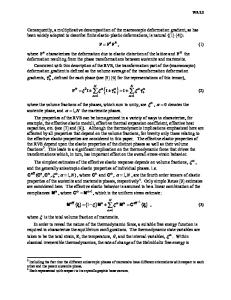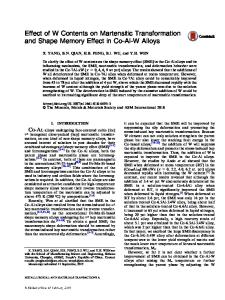Thermal arrest analysis of thermoelastic martensitic transformations in shape memory alloys
- PDF / 959,848 Bytes
- 10 Pages / 584.957 x 782.986 pts Page_size
- 63 Downloads / 338 Views
Yinong Liua) School of Mechanical and Chemical Engineering, The University of Western Australia, Crawley, Western Australia 6009, Australia; and Center for Biomedical Materials and Engineering, Harbin Engineering University, Harbin 150001, China
Tae-hyun Nam School of Materials Science and Engineering, Gyeongsang National University, Jinju, Gyeongnam 660-701, Korea
F. Chen Center for Biomedical Materials and Engineering, Harbin Engineering University, Harbin 150001, China (Received 16 December 2010; accepted 11 February 2011)
This study investigated a fundamental aspect of thermoelastic martensitic transformations in different shape memory alloys by means of interrupted thermal analysis technique using differential scanning calorimetry (DSC). The objective of this study was to determine the true transformation temperature interval. It also provides the opportunity to further the discussion of time dependence of the transformations. The study applied a technique of thermal arrest amidst phase transformations. The transformation temperature intervals were found to be 8.4 and 12.9 K for the forward and reverse B2↔B199 martensitic transformation in a near-equiatomic Ti-50.2 at.% Ni alloy and 14.7 and 12.8 K in a Ni-rich Ti-50.8 at.% Ni alloy and 7.3 and 9.1 K for the L21↔orthorhombic transformation in a Ni43Co7Mn39In11 alloy. These values were significantly smaller than those commonly reported in the literature. The experimental evidences also demonstrated that the apparent time dependences of the martensitic transformations manifested in DSC analysis were artifacts caused by instrumental thermal inertia.
I. INTRODUCTION
Near-equiatomic NiTi shape memory alloys have been used in a wide range of applications in medicine, engineering, and consumer goods owing to their unique capabilities to recover large deformation strains and to perform mechanical works. In many of these applications, shape memory alloys are actuated by temperature variations. In this regard, actuation temperature window and hysteresis are important design parameters, for example, for proportional control and as shape memory actuators.1–4 It has been established in the literature that transformation intervals of thermoelastic martensitic transformations are caused by the continuous storage of elastic strain energies.5–9 Thus, determination of the values of the intervals is important for understanding the micromechanisms of these transformations, for determining the thermodynamic parameters of these transformations, and for mechanics modeling using these parameters. Transformation thermal parameters reported in the
literature are usually determined by thermal analyses, for example, differential scanning calorimetry (DSC),5,10 thermomechanical analysis,11 and electrical resistance measurement.12–14 It is common knowledge that DSC measurement is subjected to kinetic influences of the measurement process; thus, validity of transformation interval values determined under finite heating and cooling rates needs to be verified. This study conducts experiment
Data Loading...











